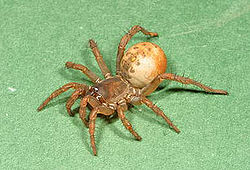- Mesothelae
-
Mesothelae 
A female Ryuthela secundaria Scientific classification 
Kingdom: Animalia Phylum: Arthropoda Class: Arachnida Order: Araneae Suborder: Mesothelae Families The Mesothelae are a suborder of spiders (Order Araneae) that includes the extinct families Arthrolycosidae and Arthromygalidae and the only extant family Liphistiidae.
The Mesothelae is thought to form the sister group to all other living spiders, representing an ancient and "primitive" line of spiders. Recent Mesothelae are characterized by the narrow sternum on the ventral side of the prosoma. Several plesiomorphic characteristics may be useful in recognizing these spiders: there are tergite plates on the dorsal side and the almost-median position of the spinnerets on the ventral side of the opisthosoma. They lack a venom gland and duct, which almost all other spiders feature.[1] All Mesothelae have four pairs of spinnerets. Like mygalomorph spiders, they have two pairs of book lungs.[2]
The Heptathelidae were once considered their own family; today they are considered a subfamily of the Liphistiidae (i.e. as Heptathelinae). Unlike all other extant mesothelians, heptathelines do not have fishing lines in front of the entrances to the burrows that they construct, making them more difficult to find. They also have a paired receptaculum (unpaired in other liphistiids), and have a conductor in their palpal organ.
Contents
Distribution
Liphistiidae spiders are distributed in Myanmar, Thailand, the Malayan peninsula and in Sumatra. Heptathelidae are found in Vietnam, the Eastern provinces of China, and Southern Japan.
In popular culture
In the BBC documentary Walking with Monsters (2005), a Carboniferous period species of Mesothelae was shown as being as large as a human head and shown hunting reptiles the size of today's cats. In the series, it is depicted as living like tarantulas in burrows and either lying in wait for its prey or chasing it through the jungle.
In fact, no spider that large has ever been found; but, at the time the series began production, the sea scorpion Megarachne had been mistakenly interpreted as a spider. The correct classification was not made until Walking With Monsters was well into production, and the giant spider was left in and called "Mesothelae" instead of Megarachne. Megarachne servinei had up until this time been considered the largest known spider.
References
- ^ Haupt, J. (2004). The Mesothelae — a monograph of an exceptional group of spiders (Araneae: Mesothelae). Zoologica 154:8 ISSN 0044-5088, ISBN 3-510-55041-2 (Abstract)
- ^ Scharff, N. & Enghoff, H. (2005). Arachnida. Zoological Museum, University of Copenhagen.
External links
Spiders Arachnology 
Taxonomy Araneomorphae · Mesothelae · Mygalomorphae · Opisthothelae · List of families of spiders · Lists of spider speciesAnatomy Arthropod leg · Book lung · Calamistrum · Cephalothorax · Chelicerae · Cheliceral fang · Cribellum · Epigyne · Exuvia · Opisthosoma · Pedipalp · Scopulae · Silk · Spinneret · Urticating hairHuman interaction Webs Spider web · Web decorationsCategory 
This spider–related article is a stub. You can help Wikipedia by expanding it.
